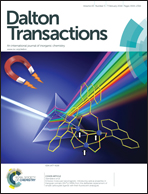Encapsulation of [X2(H2O)4]2− (X = F/Cl) clusters by pyridyl terminated tripodal amide receptor in aqueous medium: single crystal X-ray structural evidence†
Abstract
A new tris-amide receptor L based on 1,3,5-methyl substituted benzene platform and pyridyl as an attached unit is synthesized and explored towards anion recognition in aqueous environment. The presence of pyridyl terminal in L facilitates its aqueous solubility. The binding of halides and oxyanions towards L are examined by 1H-NMR technique in solution and by single crystal X-ray crystallography in solid state studies. Crystallization of fluoride and chloride with L is carried out in acetone–water (1 : 1, v/v) binary solvent mixture that yields crystals for respective host–guest complexes, [L]2·[F2(H2O)4]·[TBA]2 (1) and [L]2·[Cl2(H2O)4]·[TBA]2 (2) suitable for single crystal X-ray diffraction studies. On the other hand, complexation of L with fluoride in dioxane–acetone (1 : 1, v/v) solvent mixture, results the formation of SiF62− encapsulated complex, [L]2·[SiF6(H2O)2]·[TBA]2 (3). Crystallographic result shows the formation of [F2(H2O)4]2− and [Cl2(H2O)4]2− zipped 1D-polymeric tweezer-like assemblies of L in acetone–water (1 : 1, v/v) binary solvent mixture in complexes 1 and 2 respectively. Solution state 1H-NMR studies in D2O–acetone-d6 (1 : 19, v/v) support 1 : 4 (host–guest) binding stoichiometry of F−, Cl−, Br−, NO3−, HSO4− and H2PO4− with L. Binding constants of these investigated anions with L by 1 : 1 binding model are calculated which show the following binding order: NO3− ≈ HSO4− > F− ≈ Cl− ≈ Br− > H2PO4−. Further, solution state 19F-NMR studies are also carried out to establish the F− binding with L in DMSO-d6.
![Graphical abstract: Encapsulation of [X2(H2O)4]2− (X = F/Cl) clusters by pyridyl terminated tripodal amide receptor in aqueous medium: single crystal X-ray structural evidence](/en/Image/Get?imageInfo.ImageType=GA&imageInfo.ImageIdentifier.ManuscriptID=C3DT52694A&imageInfo.ImageIdentifier.Year=2014)

 Please wait while we load your content...
Please wait while we load your content...